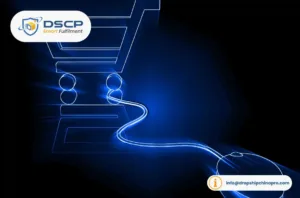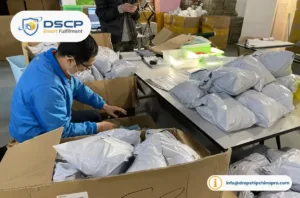Managing orders, inventory, and shipping while trying to grow your online store creates an impossible balancing act. As your sales increase, the operational burden grows exponentially—taking time away from marketing, product development, and customer relationships. This is where ecommerce product fulfillment transforms from a logistics challenge into a strategic growth enabler.
Understanding how ecommerce product fulfillment works and choosing the right approach can mean the difference between scaling smoothly and drowning in operational complexity. This guide walks you through everything you need to know to make informed decisions about your fulfillment strategy.

Key Takeaways for Ecommerce Product Fulfillment: Complete Guide for Sellers
- Fulfillment is a Strategic Growth Enabler, Not Just Logistics: While it encompasses the entire process from inventory to delivery, effective fulfillment is crucial for scaling your online store. Outsourcing or optimizing fulfillment frees up time for core growth activities like marketing and product development.
- Ecommerce Fulfillment Requires Unique Infrastructure: It fundamentally differs from traditional retail fulfillment by handling individual orders directly to consumers. This demands faster speed expectations (24-48 hour shipping), seamless platform integrations (Shopify, WooCommerce), and constant customer communication.
- Four Core Fulfillment Models Exist for Sellers:
In-house fulfillment for maximum control and very small operations (under 20-30 daily orders).
Third-party logistics (3PL) for outsourcing to specialists, leveraging scale and expertise.
Dropshipping to eliminate inventory holding, but surrenders control over speed and quality.
Hybrid fulfillment strategically combining multiple approaches (e.g., international sourcing with domestic warehousing).
- The Hybrid Model Offers the Best of Both Worlds: This approach, which pairs international sourcing (like China) with domestic US fulfillment centers, is ideal for growing sellers. It delivers the cost advantages of overseas manufacturing with the competitive speed of 2-4 day domestic delivery.
- Fulfillment Costs Are Rising: Market data shows that costs are increasing substantially, with pick-and-pack fees, storage costs, and monthly minimums all rising year-over-year. This makes strategic cost management and considering the hybrid model more important than ever.
- The Complete Fulfillment Process Involves Five Critical Steps:
- Inventory Receiving and Storage (WMS tracks location).
- Order Processing and Platform Integration (multi-channel synchronization).
- Pick, Pack, and Quality Verification (achieving 99.5%+ accuracy).
- Shipping and Carrier Optimization (using negotiated rates).
- Returns Management and Recovery (restocking sellable items quickly).
- Geographic Distribution Significantly Reduces Costs and Speeds Up Delivery: Shipping from a single location is inefficient. By distributing inventory across key locations, such as the East Coast (New Jersey) and West Coast (California), sellers can reduce shipping costs by 25-40% and cut delivery times in half by optimizing shipping zones.
- Inventory Accuracy and Peak Season Scaling are Major Challenges: Many sellers struggle with overselling due to poor multi-channel synchronization (Challenge 1) and operational collapse during holiday spikes (Challenge 2). A professional WMS and providers staffed for peak capacity are the solutions.
- Transition to Professional Fulfillment When Orders Exceed 50 Daily: The optimal time to switch from self-fulfillment to a 3PL or hybrid provider is when fulfillment takes 2-3 hours daily or your volume hits 30-50+ orders daily. Waiting too long leads to higher error rates, increased shipping costs, and customer complaints.
- Selecting a Provider Requires Careful Vetting: Prioritize providers offering no or low minimums, robust platform integrations (Shopify/WooCommerce), transparent pricing (avoiding hidden dimensional weight or long-term storage fees), and a clear plan for scalability.
What is Ecommerce Product Fulfillment?
Ecommerce product fulfillment is the end-to-end process of getting online orders from your inventory to your customers’ doorsteps. It encompasses receiving and storing products, processing orders as they arrive, picking items from warehouse shelves, packing them securely, arranging shipment through carriers, and managing returns when necessary.
Unlike traditional retail fulfillment, which often involves bulk shipments to stores, ecommerce fulfillment handles individual orders going directly to consumers. This requires different infrastructure, technology, and expertise to execute efficiently at scale.
How Ecommerce Product Fulfillment Differs from Traditional Fulfillment
The distinctions between ecommerce and traditional fulfillment create unique operational requirements:
Speed expectations have fundamentally changed. Traditional retail fulfillment operates on weekly or bi-weekly shipment schedules, while ecommerce customers expect orders to ship within 24-48 hours and arrive within 2-5 days. Some markets now demand same-day or next-day delivery as standard service.
Platform integrations form the backbone of modern ecommerce fulfillment. Systems must connect seamlessly with Shopify, WooCommerce, Amazon, and other sales channels to automatically capture orders, update inventory in real-time, and push tracking information back to customers. Traditional fulfillment rarely requires this level of technological integration.
Customer communication requirements extend throughout the fulfillment process. Ecommerce customers expect order confirmations, shipping notifications, tracking updates, and delivery confirmations—all automated through integrated systems. Traditional B2B fulfillment involves minimal direct customer communication.
| Fulfillment Model | Best For |
|---|---|
| Self-Fulfillment | Under 30 orders/day, specialized products |
| Traditional 3PL | 200+ orders/month, established businesses |
| Dropshipping | Product testing, minimal investment |
| Hybrid Fulfillment | 100-2,000 orders/month, fast + affordable |
The 4 Core Ecommerce Product Fulfillment Models
Sellers can choose from four primary fulfillment approaches, each with distinct advantages and trade-offs:
In-house fulfillment means handling all operations yourself—storing inventory in your own space, packing orders as they arrive, and coordinating carrier pickups. This approach offers maximum control and works well for very small operations (under 20-30 orders daily) or businesses with highly specialized products requiring unique handling.
Third-party logistics (3PL) involves outsourcing fulfillment to specialized providers who manage warehousing, order processing, packing, and shipping on your behalf. 3PLs leverage economies of scale, carrier relationships, and operational expertise to deliver professional fulfillment without requiring capital investment in facilities and systems.
Dropshipping eliminates inventory holding by having suppliers ship directly to customers when orders arrive. While this minimizes upfront investment, it also surrenders control over fulfillment speed, packaging quality, and customer experience. Further reading for E-commerce Fulfillment vs Dropshipping.
Hybrid fulfillment combines multiple approaches strategically. The most effective hybrid model pairs international sourcing (typically from China) with domestic fulfillment centers. Fast-moving products are stocked in US warehouses for rapid delivery, while slower-moving items ship directly from overseas to optimize inventory costs.
Further reading for Self Fulfillment vs 3PL.

The Ecommerce Product Fulfillment Market in 2025
Understanding current market dynamics helps contextualize fulfillment decisions and anticipate future trends affecting your business.
Market Size and Growth Trends
The global ecommerce logistics market reached $441.28 billion in 2024 and continues expanding rapidly (Grand View Research, 2024). North American ecommerce fulfillment specifically has grown at 15-18% annually as online shopping becomes the default purchasing method for many product categories.
Third-party fulfillment adoption has accelerated dramatically. Industry surveys indicate that 73% of ecommerce businesses are currently evaluating or changing their fulfillment approaches (Content Marketing Institute, 2025). This widespread strategic reassessment reflects growing recognition that fulfillment capabilities directly impact customer retention, operational costs, and competitive positioning.
Rising Costs and Changing Dynamics
Fulfillment economics have shifted substantially over the past two years:
- Pick and pack fees increased 7% from 2023 to 2024, with national averages now ranging from $3.50 to $5.00 per order
- Storage costs rose 14% year-over-year as warehouse capacity tightened
- Monthly minimums jumped from $195 (2023) to $337.50 (2024), with 46.67% of warehouses now requiring them (Fulfill.com, 2024)
- De minimis policy changes have made domestic fulfillment from US warehouses more cost-competitive compared to direct shipping from overseas
These shifts particularly benefit hybrid fulfillment models that combine international sourcing with domestic delivery.
How Ecommerce Product Fulfillment Works: The Complete Process
Understanding the fulfillment workflow reveals where efficiency gains and cost savings emerge—and where problems typically occur.
Step 1: Inventory Receiving and Storage
The fulfillment process begins when products arrive at the warehouse. Professional operations implement quality inspection protocols during receiving, verifying that products match purchase orders in quantity, condition, and specifications.
After verification, products move into storage locations optimized for efficient picking. Fast-moving items occupy easily accessible positions near packing stations, while slower-moving inventory goes to higher shelves or less convenient locations.
Modern warehouse management systems (WMS) track every product’s exact location, quantity, and status in real-time. When inventory levels drop to predetermined reorder points, the system generates alerts enabling proactive restocking before stockouts occur.
Step 2: Order Processing and Platform Integration
When a customer places an order on your store, the fulfillment system must capture that order automatically and begin processing immediately.
Multi-channel synchronization ensures orders from all sales channels flow into a single fulfillment system. Sophisticated integrations prevent overselling by updating available inventory across all platforms in real-time as orders process and as new inventory arrives.
Automatic order routing directs each order to the optimal fulfillment location based on business rules you define. The system also applies any special handling requirements—gift wrapping, custom packaging, expedited shipping—automatically based on what the customer selected at checkout.
Step 3: Pick, Pack, and Quality Verification
Picking accuracy determines customer satisfaction more than any other single factor. Professional fulfillment operations achieve accuracy rates exceeding 99.5% through systematic processes and technology.
The workflow includes:
- Warehouse staff receive optimized pick lists on mobile devices
- They scan barcodes as they select each item for verification
- At packing stations, staff select appropriate packaging materials
- A final quality check verifies the contents before sealing
- The system generates optimized shipping labels
Packaging optimization balances protection requirements with cost considerations—dimensional weight pricing means oversized boxes directly increase shipping costs even if actual weight remains light.
Step 4: Shipping and Carrier Optimization
With the package prepared, the system evaluates multiple carriers (USPS, UPS, FedEx, regional carriers) and service levels to identify the most cost-effective option that meets delivery timeframe requirements.
Professional fulfillment providers maintain negotiated rates with multiple carriers, often achieving 20-40% savings compared to retail shipping rates. Real-time tracking begins the moment the carrier accepts the package, with tracking information automatically pushed back to your ecommerce platform.
Step 5: Returns Management and Recovery
Returns are inevitable in ecommerce—industry averages range from 20-30% for apparel to 5-10% for other product categories. How you handle returns impacts both customer satisfaction and your bottom line.
The returns process includes:
- Generating return labels and providing clear instructions
- Inspecting returned products to determine condition
- Categorizing items as resaleable, damaged, or defective
- Quickly restocking sellable products to available inventory
- Refurbishing items when economically viable
- Tracking return reasons to identify quality issues
Advanced systems focus on inventory recovery strategies that quickly return sellable products to available inventory, minimizing the time products sit in returns limbo. Further reading for Product Fulfillment Services.
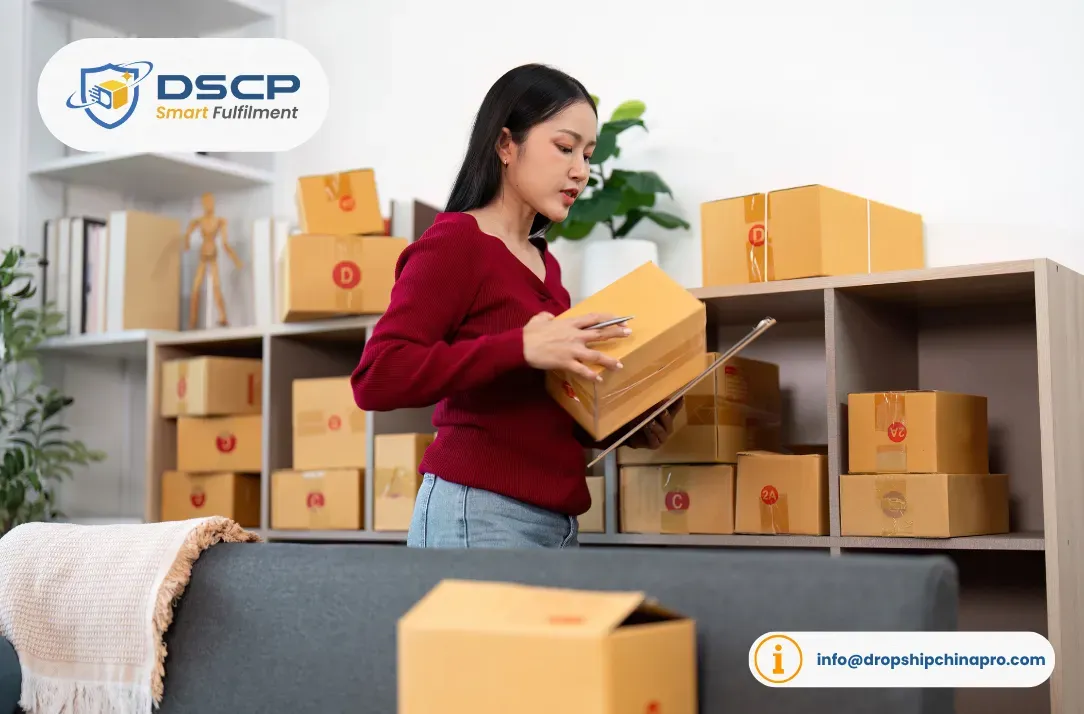
Ecommerce Product Fulfillment for Different Platforms
Platform-specific considerations affect both your fulfillment approach and provider selection.
Shopify Product Fulfillment Solutions
Shopify sellers have multiple fulfillment paths available. Third-party fulfillment apps in the Shopify App Store provide broader options, syncing inventory, automatically forwarding orders to fulfillment centers, and pushing tracking information back to Shopify—creating a seamless experience for both merchants and customers.
The most successful Shopify sellers often use hybrid approaches, maintaining some inventory in domestic fulfillment centers for fast-moving products while using alternative methods for slower items.
WooCommerce Fulfillment Integration
WooCommerce’s open-source nature provides exceptional flexibility but requires more technical setup than Shopify. Fulfillment providers offer WooCommerce plugins that handle order synchronization, inventory updates, and tracking information.
Because WooCommerce runs on your own hosting, you maintain complete control over data and can customize fulfillment workflows extensively. This flexibility benefits businesses with complex requirements but requires more technical expertise.
Multi-Channel Selling and Fulfillment
Selling across multiple platforms—your Shopify store, Amazon, eBay, Etsy, social commerce—creates inventory synchronization challenges. Without proper integration, you risk overselling products that show available on multiple channels but exist only once in your warehouse.
Professional fulfillment systems act as the single source of truth for inventory. When an item sells on any channel, the system immediately decrements available inventory across all platforms. This centralized inventory management prevents overselling while maximizing sales opportunities.
| Cost Component | Typical Range |
|---|---|
| Pick & Pack Fees | $3.50 – $5.00 per order |
| Storage Fees | $0.50 – $2.00 per cubic foot/month |
| Shipping Costs | $6 – $9 per package (3PL rates) |
| Returns Processing | $4 – $7 per return |
| Monthly Minimums | $300 – $500 (if required) |
The True Cost of Ecommerce Product Fulfillment
Understanding comprehensive costs enables accurate comparison between fulfillment approaches and realistic profit margin calculations.
Pricing Breakdown: What You Actually Pay
Typical fulfillment costs include:
- Storage fees: $0.50 to $2.00 per cubic foot monthly, with long-term storage (over 90-180 days) incurring additional fees
- Pick and pack charges: $3.50 to $5.00 per standard order, with complex orders costing $6-8
- Shipping costs: Vary by weight, dimensions, and destination—typically $6-9 per package through fulfillment providers versus $10-15 at retail rates
- Integration fees: May include setup costs ($100-500 one-time), monthly platform fees ($50-200), and per-transaction charges ($0.10-0.40)
Hidden Costs Most Sellers Miss
Beyond obvious fees, watch for:
Dimensional weight pricing from carriers means they charge based on package size, not just actual weight. A large, light package might ship at the equivalent of 10 pounds even if it only weighs 2 pounds.
Long-term storage penalties accumulate quickly. Items sitting unsold for over 180 days might incur additional fees of $2-5 per cubic foot monthly, potentially exceeding the original product cost within a year.
Minimum order requirements effectively increase your per-order cost when volumes fall below minimums. If a provider requires a $500 monthly minimum but you only process $300 in fulfillment fees, you pay the $500 anyway.
Returns processing fees add $4-7 per return for inspection, restocking, and inventory updates. With return rates of 20-30% in some categories, these costs substantially impact profitability.
Cost Comparison: Self-Fulfillment vs 3PL vs Hybrid
The economics shift dramatically at different volume levels:
At 20-30 orders daily, self-fulfillment often appears cheaper on paper but typically ignores your time (worth $25-50+ per hour), storage space costs, and retail shipping rates that run 30-50% higher than 3PL negotiated rates.
At 50-100 orders daily, 3PL economics become compelling. The 3PL’s carrier discounts alone often save $2,000-4,000 monthly, while you avoid 3-5 hours daily of fulfillment work.
With 200+ orders daily, self-fulfillment becomes nearly impossible without substantial infrastructure investment, including commercial warehouse space, full-time staff, and warehouse management systems.
Hybrid fulfillment offers unique economics by combining the advantages of multiple approaches—fast-moving inventory in US warehouses provides 2-4 day delivery at 3PL rates, while slower items ship directly from international suppliers.
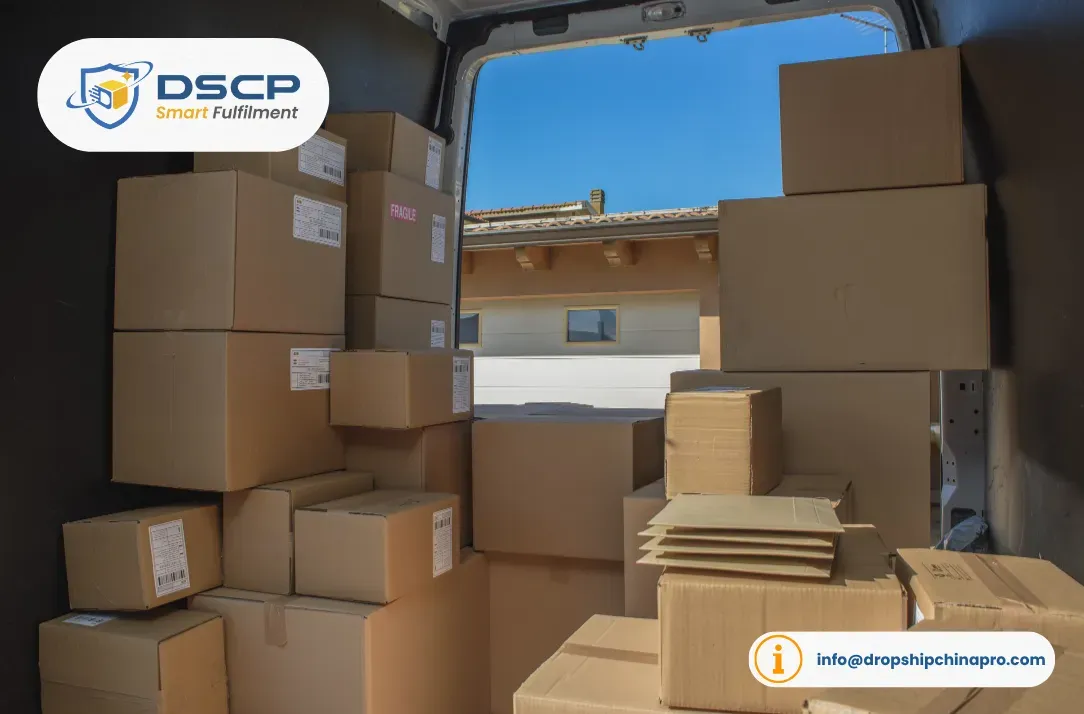
Hybrid Ecommerce Product Fulfillment: The Best of Both Worlds
Traditional fulfillment models force an either-or choice between speed and cost. Hybrid fulfillment eliminates this trade-off through a strategic approach combination.
What is Hybrid Fulfillment?
Hybrid fulfillment strategically combines multiple fulfillment methods to optimize different aspects of your operations. The most effective hybrid model pairs international sourcing (typically from China, where manufacturing costs remain significantly lower) with domestic fulfillment centers in the United States.
How it works:
- Source products from verified Chinese suppliers
- Ship inventory to US-based warehouses via ocean freight
- Store products in California and New Jersey fulfillment centers
- Process and ship orders domestically for 2-4 day delivery
This approach delivers Chinese manufacturing costs with domestic delivery speeds—a combination traditional models can’t match. You avoid the 15-30 day delivery times of direct-from-China shipping while maintaining the cost advantages that make your products competitive.
When Hybrid Fulfillment Makes Sense for Your Business
Hybrid fulfillment works exceptionally well for specific business profiles:
Order volume between 100-2,000 monthly represents the sweet spot. Below 100 orders, you might still manage self-fulfillment effectively. Above 2,000 orders, you can likely negotiate favorable rates with traditional 3PLs.
Product characteristics that favor hybrid include relatively lightweight items (under 5 pounds), non-perishable goods, and products without extreme fragility. Fashion, accessories, home goods, consumer electronics, and pet products work particularly well.
Budget constraints often make a hybrid appealing. Traditional 3PLs increasingly require minimum monthly fees ($300-500+), while hybrid providers more commonly offer pay-as-you-go pricing where you only pay for orders actually fulfilled.
Growth trajectory matters significantly. If you’re scaling from 50 to 500+ orders monthly, hybrid fulfillment grows with you without requiring provider changes or operational disruptions.
Real Example: How Hybrid Fulfillment Reduces Costs by 40%
A Shopify seller offering phone accessories struggled with fulfillment. Shipping directly from China meant 18-25 day delivery times and 8-12% of shipments getting lost or delayed. Customer complaints mounted and repeat purchase rates remained below 15%.
They tested a traditional US-based 3PL requiring $500 monthly minimums. At 150 orders monthly, their total cost was $525 fulfillment plus $1,200 shipping—$11.50 per order all-in.
After switching to hybrid fulfillment with no minimums and $2.85 pick/pack fees:
- Container shipping: $3,000 for 3,000 units = $1 per unit freight cost
- Fulfillment fees: $2.85 × 150 orders = $427.50 monthly
- Total cost: $427.50 + $1,200 shipping = $1,627.50 monthly ($10.85 per order)
More importantly, delivery times dropped to 2-4 days, customer satisfaction scores increased 34%, and repeat purchase rates more than doubled to 37%. The improved customer experience drove revenue growth that far exceeded the direct cost savings.
| Warehouse Location | Key Advantages |
|---|---|
| California (LA) | West Coast coverage, China import hub, 50M consumers |
| New Jersey | East Coast density, 100M+ consumers, 2-day delivery |
| Dual-Coast Strategy | Nationwide 2-4 day delivery, 25-40% shipping savings |
US Warehouse Strategy for Ecommerce Product Fulfillment
Geographic distribution strategy can reduce shipping costs 25-40% while cutting delivery times in half—yet many sellers overlook this powerful optimization lever.
Why Geographic Distribution Matters
When you ship from a single location, packages destined for distant customers travel through multiple carrier zones, accumulating charges at each zone boundary. A package from Los Angeles to Miami crosses 8 shipping zones; each zone adds $1-2 to the cost.
Strategic warehouse positioning delivers:
- 2-4 day delivery capabilities as standard service
- Shipping zone optimization reducing costs $4-6 per package
- Customer satisfaction improvements through shorter transit times
- Fewer lost or damaged packages due to reduced handling
East Coast vs West Coast Warehousing
Each coast offers distinct advantages for different seller profiles:
California (LA area) provides optimal access to:
- West Coast population centers (LA, San Francisco, Seattle, Portland)
- Pacific Rim import infrastructure for container shipping from Asia
- 40-50 million consumers within 2-3 days of ground delivery
Businesses sourcing from China often choose California as their primary US warehouse location. Container ships arrive directly at Los Angeles or Long Beach ports, and products clear customs locally before moving short distances to fulfillment warehouses.
New Jersey (Newark/New Brunswick area) serves:
- East Coast population density (New York, Philadelphia, Boston, DC corridor)
- 100+ million consumers within 2-day ground delivery
- Major carrier sorting facilities enabling efficient distribution
For sellers with customer bases concentrated on the East Coast or those offering expedited shipping as a competitive advantage, New Jersey warehouses deliver unmatched performance.
How Multi-Warehouse Distribution Works
Operating inventory across multiple warehouses requires sophisticated systems:
- Inventory allocation uses historical sales data and customer location patterns to determine optimal stock levels at each warehouse
- Automatic routing directs each order to the geographically closest warehouse with inventory available
- Cost optimization algorithms consider trade-offs between split shipments and consolidated shipping
This intelligent distribution requires no manual intervention once properly configured. Orders flow to optimal fulfillment locations automatically, inventory rebalancing happens systematically, and you gain visibility through dashboards showing delivery times, shipping costs, and inventory health by location.
Common Ecommerce Product Fulfillment Challenges (And How to Solve Them)
Understanding typical pitfalls and their solutions prevents costly mistakes and accelerates your path to fulfillment excellence.
Challenge 1: Inventory Accuracy Issues
Nothing erodes customer trust faster than showing products available only to email later, saying they’re actually out of stock. Inventory accuracy problems plague many sellers, especially those managing multiple sales channels.
Root causes include:
- Manual inventory updates that lag actual stock levels
- Failure to sync inventory across multiple sales platforms
- Inadequate tracking during receiving processes
- No systematic cycle counting to catch discrepancies
Solutions: WMS systems address these issues through barcode scanning at every touch point. Real-time syncing between your fulfillment system and sales platforms prevents overselling—when a product sells on Shopify, available quantity decrements immediately across all connected channels.
Challenge 2: Peak Season Scaling
Holiday seasons or viral social media moments can spike order volume 3-10x normal levels within days. Self-fulfillment operations collapse under this pressure, creating backlogs that take weeks to clear.
Solutions: Professional fulfillment providers staff for peak capacity, not average volume. When your orders spike from 50 daily to 400, they simply allocate more staff without you managing hiring or training. Pay-as-you-go fulfillment models that scale both up and down prove essential for businesses with volatile order patterns.
Challenge 3: Returns Management
High return rates in certain product categories turn profitability into losses without efficient returns processing. Fashion items see 20-30% return rates; some categories reach 40%. Each return costs $8-12 to process while the product sits in limbo rather than generating revenue.
Solutions: Systematic reverse logistics process returns with clear workflows:
- Returns receive inspection within 24-48 hours
- Products are categorized as resaleable, refurbishable, or defective
- Resaleable items restock immediately
- Quality recovery programs maximize value retention through restocking and refurbishment
This approach recovers 60-80% of product value from returns while maintaining quality standards.
Challenge 4: Integration Complexity
Technical barriers prevent many sellers from leveraging professional fulfillment even when the economics make sense. Without proper integration, you’re manually entering orders, updating tracking numbers, and syncing inventory—all error-prone and time-consuming.
Solutions: Top fulfillment providers offer certified apps or plugins for major platforms like Shopify and WooCommerce that handle most configuration automatically. You should be able to connect your store, map your products, and start fulfilling orders within hours—not days or weeks. Real human support who understand both fulfillment operations and ecommerce platforms prevents small problems from becoming business disruptions.
| Must-Have Feature | Why It Matters |
|---|---|
| No Monthly Minimums | Avoid paying for unused capacity |
| Platform Integration | Automatic order sync, no manual entry |
| Transparent Pricing | Accurate profitability calculations |
| 99%+ Accuracy Rate | Protects customer satisfaction and reviews |
| Scalability to 10x Volume | Avoid switching providers as you grow |
How to Choose an Ecommerce Product Fulfillment Provider
Provider selection determines your operational experience for months or years. Making the right choice requires systematic evaluation.
Essential Requirements for Small to Mid-Size Sellers
Certain baseline capabilities prove non-negotiable:
- No or low minimums enable you to start professional fulfillment before reaching a massive scale
- Platform integrations for your specific ecommerce stack must work reliably
- Transparent pricing with clear per-order costs enables accurate profitability calculations
- Scalability to accommodate 5-10x growth without changing providers
10 Questions to Ask Before Choosing a Provider
- What are your monthly minimum requirements, if any?
- What is your average order accuracy rate, and how do you measure it?
- Which ecommerce platforms do you integrate with, and how robust are those integrations?
- What are your typical order processing and shipping timeframes?
- How do you handle peak season volume increases?
- What is your returns processing workflow and timeline?
- What are all your fees—storage, pick and pack, shipping, receiving, technology, and others?
- Where are your fulfillment centers located geographically?
- What level of customer support do you provide, and what are your response times?
- What is your contract length and what are termination terms?
Red Flags to Avoid
Watch for these warning signs:
- Hidden fees that only appear after you’ve committed create budget surprises
- Long-term contracts (12-24 months) with substantial early termination penalties trap you
- Poor communication during sales conversations predicts worse communication during operations
- Limited integration options, forcing manual order entry defeat the primary benefits of professional fulfillment
When to Switch from Self-Fulfillment to Ecommerce Product Fulfillment
Timing this transition optimally prevents the chaos of waiting too long while avoiding the unnecessary expense of switching too early.
Signs You’ve Outgrown Self-Fulfillment
Multiple indicators signal when professional fulfillment becomes necessary:
- Time consumption: Fulfillment activities exceeding 2-3 hours daily (30-40+ hours monthly)
- Order volume: Processing 50+ orders daily makes self-fulfillment nearly impossible
- Error rate increases: Mistakes rise as you rush through orders in a limited time
- Shipping cost inefficiencies: Paying 30-50% more than commercial rates
At 10 orders daily, shipping overpayment might represent $50-100 monthly. At 100 orders daily, you’re losing $500-1,000 monthly to avoidable charges.
The Transition Process: What to Expect
Moving from self-fulfillment to professional service requires planning:
Timeline: 30-60 days from provider selection through full transition
- Week 1-2: Provider evaluation, selection, and contract
- Week 3-4: Technical integration setup and testing
- Week 5-6: Physical inventory transfer
- Week 7-8: Parallel operations and final cutover
Inventory transfer requires careful planning to avoid stockouts during transition. Most sellers maintain minimal inventory locally while gradually sending products to the new fulfillment center in phases. Start with a subset of products—perhaps your 20-30 fastest-moving SKUs—then expand once those items flow smoothly. Further reading for Fulfillment Center.
System integration demands thorough testing before going live. Process 10-20 test orders through the complete workflow—order placement on your site, automatic forwarding to the fulfillment system, picking and packing, shipping, and tracking number updates back to your store. Verify every step works correctly before directing real customer orders through the new system.
A testing period of 1-2 weeks running parallel operations provides safety. Continue fulfilling a small percentage of orders yourself while the new provider handles the majority. This lets you verify quality, accuracy, and timing before fully committing. Monitor order accuracy, shipping speeds, customer feedback, and any issues requiring resolution.
| Warning Sign | Impact |
|---|---|
| 50+ Orders Daily | Self-fulfillment becomes unsustainable |
| 3+ Hours Daily on Fulfillment | Opportunity cost of $2,000-5,000/month |
| Rising Error Rates | Customer complaints and negative reviews |
| Retail Shipping Rates | Paying 30-50% more than necessary |
| Peak Season Overwhelm | Missed growth opportunities and delays |
Real Success Story: A Seller Who Transformed Their Business
Sarah launched a Shopify store selling sustainable home goods. At 100 orders monthly, she managed fulfillment from her garage—consuming 15-20 hours weekly.
The challenge: A successful Instagram campaign doubled orders overnight to 200+ monthly. Sarah found herself working until midnight packing orders, falling behind on shipments, and receiving complaints about slow delivery.
The solution: She partnered with a hybrid fulfillment provider offering:
- Verified Chinese suppliers committed to sustainable manufacturing
- Ocean freight shipping to US warehouses (lower carbon footprint)
- Recyclable, minimal packaging materials
- Pay-as-you-go pricing without minimums
The results:
- Reclaimed 15-20 hours weekly for marketing and product development
- Delivery time dropped from 7-10 days to 3-5 days
- Customer satisfaction scores increased from 4.2 to 4.7 stars
- Total per-order cost decreased 12% despite paying for professional fulfillment
- Monthly orders grew from 200 to 850 within six months
- Repeat purchase rates increased from 22% to 41%
FAQs for Ecommerce Product Fulfillment
What is ecommerce product fulfillment?
Ecommerce product fulfillment is the complete process of storing inventory, processing customer orders, picking and packing products, shipping packages, and handling returns for online stores. It includes everything from the moment a customer clicks “buy” until the product arrives at their door. Businesses can handle this in-house, outsource to third-party logistics (3PL) providers, or use hybrid models combining both approaches.
What are the 4 types of ecommerce fulfillment?
The four main ecommerce fulfillment models are:
- In-house fulfillment – You handle all storage, packing, and shipping yourself
- Third-party logistics (3PL) – Professional providers manage your entire fulfillment operation
- Dropshipping – Suppliers ship directly to customers without you holding inventory
- Hybrid fulfillment – Combines international sourcing with domestic warehouses for cost and speed advantages
Each model works best for different business sizes, order volumes, and growth stages.
How much does ecommerce product fulfillment cost?
Typical ecommerce fulfillment costs include pick and pack fees ($3.50-$5.00 per order), storage ($0.50-$2.00 per cubic foot monthly), and shipping ($6-$9 per package with 3PL rates). Some providers require monthly minimums of $300-$500. Returns processing adds $4-$7 per return. Total cost per order typically ranges from $10-$15, depending on product size, weight, and destination. Pay-as-you-go providers without minimums offer more flexibility for smaller sellers.
Does Shopify do product fulfillment?
Shopify offers its own Fulfillment Network service, but availability is limited and costs can be higher than alternatives. Most Shopify sellers use third-party fulfillment providers that integrate through the Shopify App Store. These certified apps automatically sync orders, update inventory in real-time, and push tracking numbers back to your store. Popular options include traditional 3PLs, hybrid fulfillment providers, and specialized services for different product types.
When should I switch from self-fulfillment to a fulfillment service?
Switch to professional fulfillment when you’re processing 50+ orders daily, spending more than 3 hours daily on fulfillment tasks, experiencing rising error rates, or paying retail shipping rates. The break-even point typically occurs at 30-50 orders daily. If fulfillment is preventing you from focusing on marketing and growth, or if you can’t offer competitive 2-4 day delivery times, it’s time to consider outsourcing.
What’s the difference between ecommerce fulfillment and dropshipping?
Ecommerce fulfillment means you own and control inventory stored in warehouses (yours or a 3PL’s), providing faster delivery and consistent quality. Dropshipping means suppliers ship directly to customers without you holding inventory, requiring minimal upfront investment but surrendering control over shipping speeds and packaging quality. Fulfillment typically delivers in 2-5 days, while dropshipping often takes 10-30 days. Fulfillment offers a better customer experience but requires inventory investment.
How does hybrid ecommerce fulfillment work?
Hybrid fulfillment combines international sourcing (typically from China) with domestic warehouses in the US. You source products from verified suppliers at competitive prices, ship inventory via ocean freight to US fulfillment centers (like California and New Jersey), then fulfill orders domestically for 2-4 day delivery. This provides Chinese manufacturing costs with domestic delivery speeds—offering both affordability and fast shipping. It works best for sellers processing 100-2,000 orders monthly who want professional fulfillment without high minimums.
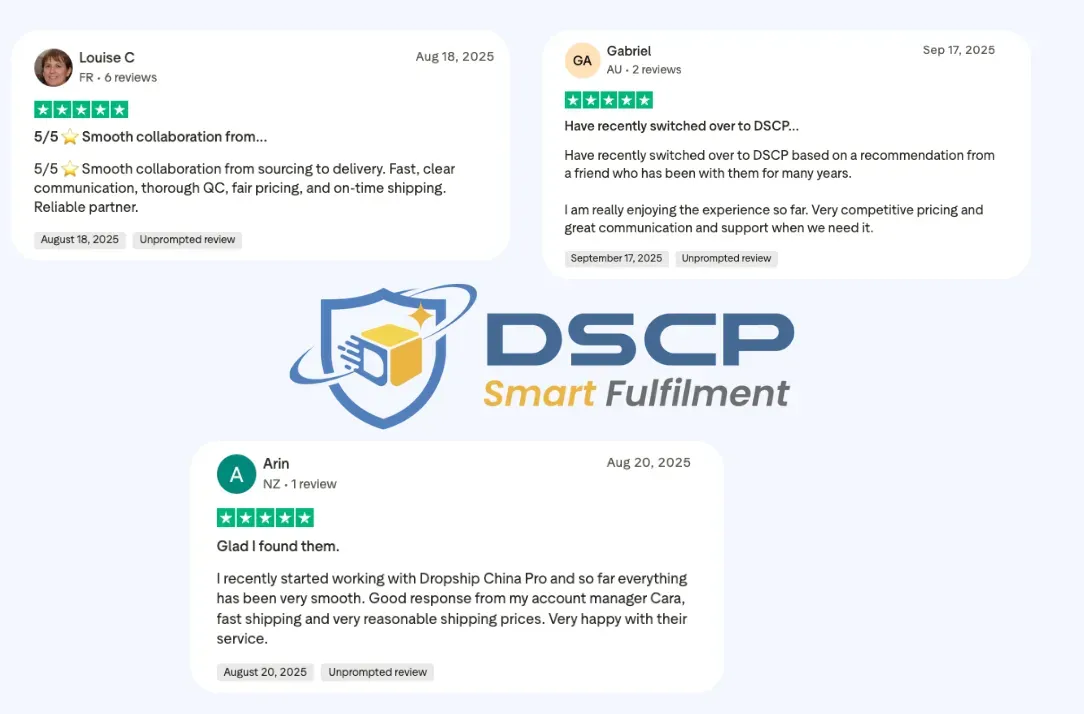
What Our Clients Say About Ecommerce Product Fulfillment
Real experiences from sellers who transformed their fulfillment operations reveal the impact of choosing the right partner. These testimonials highlight what matters most: reliable service, clear communication, and results that drive business growth.
Louise describes her experience with DSCP Smart Fulfillment as remarkably smooth from start to finish. The collaboration spans the entire process—from sourcing products to final delivery. She emphasizes the fast and clear communication that keeps operations running without surprises.
Thorough quality control caught potential issues before they reached customers, while fair pricing eliminated budget concerns. On-time shipping became the standard, not the exception. For Louise, reliability defines the partnership—exactly what growing ecommerce sellers need when scaling operations.
Arin recently started working with DSCP Smart Fulfillment and couldn’t be more satisfied with the decision. Everything has progressed smoothly from day one, with responsive support from account manager Cara making the transition seamless. The combination of fast shipping and reasonable shipping prices solved the dual challenge most sellers face—delivering quickly without destroying margins.
Arin’s enthusiasm reflects the confidence that comes from finding a fulfillment partner who delivers on promises consistently. For sellers exploring professional fulfillment for the first time, this experience demonstrates how the right provider removes operational stress while improving customer satisfaction.
Gabriel made the switch to DSCP based on a friend’s recommendation—someone who had been with them for many years. That long-term relationship spoke volumes about service quality and reliability. Now experiencing it firsthand, Gabriel understands why his friend stayed loyal. The competitive pricing keeps costs manageable while scaling, and the great communication ensures he gets support exactly when needed.
Switching fulfillment providers involves risk and disruption, but Gabriel’s experience shows that choosing a provider with a proven track record and genuine customer focus makes the transition worthwhile. His testimonial reinforces what matters most: consistent performance over years, not just months.
These success stories share common themes that define exceptional ecommerce product fulfillment: proactive communication, competitive pricing without hidden surprises, fast and reliable shipping, and account managers who genuinely understand the business. When sellers find partners demonstrating these qualities consistently, fulfillment transforms from operational burden into competitive advantage—freeing time and resources to focus on what drives growth.
Getting Started with Ecommerce Product Fulfillment
Ready to make the switch? Start by assessing your current fulfillment costs comprehensively—including packaging materials, shipping, time spent, storage space, and any staffing. Calculate your break-even point where professional fulfillment equals self-fulfillment (typically around 30-50 orders daily).
Request quotes from 3-5 providers after defining your requirements, then test integration compatibility through trial periods or pilot programs before fully committing.
Why DSCP Smart Fulfillment Works for Growing Sellers
DSCP Smart Fulfillment specializes in hybrid fulfillment that combines Chinese manufacturing economics with domestic delivery speeds. The approach is designed specifically for small to mid-size ecommerce sellers processing 100-2,000 orders monthly.
What sets it apart:
- Source from verified Chinese suppliers with quality inspection, ship via ocean freight to US warehouses
- Fulfill from Los Angeles and New Brunswick facilities for optimal US coverage
- Pay only for orders fulfilled—no monthly minimums
- Certified Shopify and WooCommerce apps for seamless integration
- 1,500+ active stores with 4.9/5 Trustpilot rating
- Capacity to handle 8,000+ orders daily
For sellers who source internationally and need domestic delivery speeds without prohibitive minimums, this hybrid model provides a compelling alternative to traditional 3PL providers.
Have questions about transitioning to professional fulfillment? Contact us—our team is ready to walk you through the process and answer any concerns.

Conclusion
Ecommerce product fulfillment has become a strategic capability that directly impacts your ability to grow. The right approach depends on your current order volume, growth trajectory, and business model—but waiting until you’re overwhelmed forces rushed decisions.
The hybrid model combining international sourcing with US warehousing offers growing sellers the best of both worlds: competitive product costs and fast domestic delivery. What was once available only to large enterprises is now accessible to businesses of any size.
Focus on finding a fulfillment partner who understands your business and can scale with you. The best relationships involve providers who offer clear communication, transparent pricing, and genuine support—not just transactional service.
Choose wisely, transition strategically, and let professional fulfillment become your competitive advantage rather than an operational burden.
References
- Content Marketing Institute. (2025). B2B Content Marketing Benchmarks, Budgets, and Trends: Outlook for 2025.
- Fulfill.com. (2024). Fulfillment Pricing Guide 2024: Cost Analysis and Market Trends.
- Grand View Research. (2024). Ecommerce Logistics Market Size, Share & Trends Analysis Report.
- Supply Chain Dive. (2024). Fulfillment Cost Trends: Annual Industry Report.

Hi, I’m Yavuz. I help e-commerce businesses grow through strategic content and SEO. Here, I share insights on fulfillment solutions, 3PL partnerships, and digital marketing strategies based on real data and industry trends.


